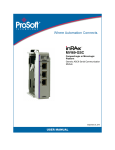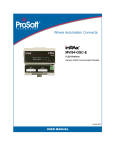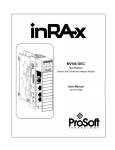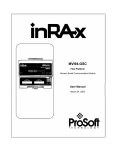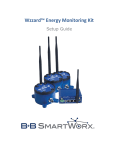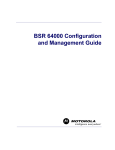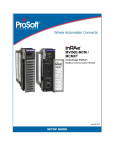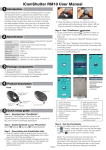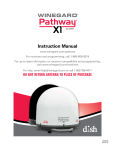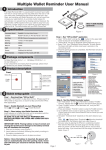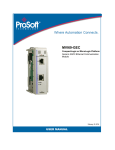Download MVI56E-GSC Setup Guide
Transcript
MVI56E-GSC ControlLogix Platform Generic ASCII Serial Communicaton Module 10/27/2009 SETUP GUIDE Important Installation Instructions Power, Input, and Output (I/O) wiring must be in accordance with Class I, Division 2 wiring methods, Article 501-4 (b) of the National Electrical Code, NFPA 70 for installation in the U.S., or as specified in Section 18-1J2 of the Canadian Electrical Code for installations in Canada, and in accordance with the authority having jurisdiction. The following warnings must be heeded: A B C D WARNING - EXPLOSION HAZARD - SUBSTITUTION OF COMPONENTS MAY IMPAIR SUITABILITY FOR CLASS I, DIV. 2; WARNING - EXPLOSION HAZARD - WHEN IN HAZARDOUS LOCATIONS, TURN OFF POWER BEFORE REPLACING OR WIRING MODULES WARNING - EXPLOSION HAZARD - DO NOT DISCONNECT EQUIPMENT UNLESS POWER HAS BEEN SWITCHED OFF OR THE AREA IS KNOWN TO BE NONHAZARDOUS. THIS DEVICE SHALL BE POWERED BY CLASS 2 OUTPUTS ONLY. MVI (Multi Vendor Interface) Modules WARNING - EXPLOSION HAZARD - DO NOT DISCONNECT EQUIPMENT UNLESS POWER HAS BEEN SWITCHED OFF OR THE AREA IS KNOWN TO BE NON-HAZARDOUS. AVERTISSEMENT - RISQUE D'EXPLOSION - AVANT DE DÉCONNECTER L'EQUIPMENT, COUPER LE COURANT OU S'ASSURER QUE L'EMPLACEMENT EST DÉSIGNÉ NON DANGEREUX. CL I Div 2 GPs A, B, C, D Temp Code T5 II 3 G Ex nA IIC T5 X 0° C <= Ta <= 60° C II - Equipment intended for above ground use (not for use in mines). 3 - Category 3 equipment, investigated for normal operation only. G - Equipment protected against explosive gasses. Warnings North America Warnings A B C Warning - Explosion Hazard - Substitution of components may impair suitability for Class I, Division 2. Warning - Explosion Hazard - When in Hazardous Locations, turn off power before replacing or rewiring modules. Warning - Explosion Hazard - Do not disconnect equipment unless power has been switched off or the area is known to be nonhazardous. Suitable for use in Class I, division 2 Groups A, B, C and D Hazardous Locations or Non-Hazardous Locations. ATEX Warnings and Conditions of Safe Usage: Power, Input, and Output (I/O) wiring must be in accordance with the authority having jurisdiction A B C D Warning - Explosion Hazard - When in hazardous locations, turn off power before replacing or wiring modules. Warning - Explosion Hazard - Do not disconnect equipment unless power has been switched off or the area is known to be non-hazardous. These products are intended to be mounted in an IP54 enclosure. The devices shall provide external means to prevent the rated voltage being exceeded by transient disturbances of more than 40%. This device must be used only with ATEX certified backplanes. DO NOT OPEN WHEN ENERGIZED. Electrical Ratings Backplane Current Load: 800 mA @ 5 V DC; 3mA @ 24V DC Operating Temperature: 0 to 60°C (32 to 140°F) Storage Temperature: -40 to 85°C (-40 to 185°F) Shock: 30g Operational; 50g non-operational; Vibration: 5 g from 10 to 150 Hz Relative Humidity 5% to 95% (non-condensing) All phase conductor sizes must be at least 1.3 mm(squared) and all earth ground conductors must be at least 4mm(squared). Markings: ANSI / ISA ISA 12.12.01 Class I Division 2, GPs A, B, C, D CSA/cUL C22.2 No. 213-1987 CSA CB Certified IEC61010 ATEX EN60079-0 Category 3, Zone 2 EN60079-15 243333 Battery Life Advisory The module uses a rechargeable Lithium Vanadium Pentoxide battery to backup the real-time clock and CMOS settings. The battery itself should last for the life of the module. However, if left in an unpowered state for 14 to 21 days, the battery may become fully discharged and require recharging by being placed in a powered-up ControlLogix chassis. The time required to fully recharge the battery may be as long as 24hours. Once it is fully charged, the battery provides backup power for the CMOS setup and the real-time clock for approximately 21 days. Before you remove a module from its power source, ensure that the battery within the module is fully charged (the BATT LED on the front of the module goes OFF when the battery is fully charged). If the battery is allowed to become fully discharged, the module will revert to the default BIOS and clock settings. Note: The battery is not user-replaceable or serviceable. Your Feedback Please We always want you to feel that you made the right decision to use our products. If you have suggestions, comments, compliments or complaints about the product, documentation, or support, please write or call us. ProSoft Technology 5201 Truxtun Ave., 3rd Floor Bakersfield, CA 93309 +1 (661) 716-5100 +1 (661) 716-5101 (Fax) www.prosoft-technology.com [email protected] Copyright © ProSoft Technology, Inc. 2009. All Rights Reserved. MVI56E-GSC Setup Guide 10/27/2009 ® ® ® ® ® ProSoft Technology , ProLinx , inRAx , ProTalk , and RadioLinx are Registered Trademarks of ProSoft Technology, Inc. All other brand or product names are or may be trademarks of, and are used to identify products and services of, their respective owners. ProSoft Technology® Product Documentation In an effort to conserve paper, ProSoft Technology no longer includes printed manuals with our product shipments. User Manuals, Datasheets, Sample Ladder Files, and Configuration Files are provided on the enclosed CD-ROM, and are available at no charge from our web site: www.prosoft-technology.com Printed documentation is available for purchase. Contact ProSoft Technology for pricing and availability. North America: +1.661.716.5100 Asia Pacific: +603.7724.2080 Europe, Middle East, Africa: +33 (0) 5.3436.87.20 Latin America: +1.281.298.9109 Contents Setup Guide MVI56E-GSC ♦ ControlLogix Platform Generic ASCII Serial Communicaton Module Contents Important Installation Instructions................................................................................................... 2 MVI (Multi Vendor Interface) Modules ............................................................................................ 2 Warnings....................................................................................................................................... 2 Battery Life Advisory...................................................................................................................... 3 Your Feedback Please................................................................................................................... 4 ® ProSoft Technology Product Documentation ................................................................................ 4 1 Scope 1.1 1.2 1.3 2 7 Learning Objectives .............................................................................................. 7 ProSoft Technology Documentation ...................................................................... 7 Prerequisites......................................................................................................... 8 Before You Begin 2.1 2.2 2.3 2.4 2.5 3 What's New?......................................................................................................... 9 What's Different?................................................................................................. 10 System Requirements......................................................................................... 11 Required Items.................................................................................................... 12 Sample Files....................................................................................................... 12 Install the Configuration Tools 3.1 3.2 4 13 Install ProSoft Discovery Service......................................................................... 13 Install ProSoft Configuration Builder .................................................................... 14 The Sample Application 4.1 4.2 4.3 5 9 15 Overview............................................................................................................. 15 Architecture......................................................................................................... 15 Data Flow ........................................................................................................... 16 Procedures 5.1 5.2 5.3 5.4 5.5 5.6 5.7 ProSoft Technology, Inc. October 27, 2009 19 Required Steps ................................................................................................... 19 Physical Setup .................................................................................................... 20 Load the Sample Application............................................................................... 23 Sample Application Setup ................................................................................... 24 Download the Sample Program to the Processor................................................. 30 Reboot the Module to Transfer New Parameter Values ....................................... 31 Verify Communication ......................................................................................... 32 Page 5 of 56 MVI56E-GSC ♦ ControlLogix Platform Generic ASCII Serial Communicaton Module Contents Setup Guide 6 Building on Success 45 7 Frequently Asked Questions 47 7.1 What are the differences between the MVI56 and the MVI56E modules? What does the "E" stand for?................................................................................................................ 47 7.2 Is the MVI56E product a direct replacement to my existing MVI56 product? ........ 47 7.3 How is the MVI56E-GSC configured? ................................................................. 48 7.4 What is ProSoft Configuration Builder (PCB)?..................................................... 48 7.5 What is ProSoft Discovery Service (PDS)?.......................................................... 48 7.6 What is the purpose of the MVI56E-GSC Ethernet Config (E1) Port? .................. 48 7.7 How do I change the module’s IP address?......................................................... 48 7.8 Does the MVI56E-GSC module require processor logic?..................................... 49 7.9 What is the purpose of the optional MVI56E-GSC Add-On Instruction? ............... 49 7.10 How do I monitor MVI56E-GSC operation? ......................................................... 49 7.11 Are there any other ways to monitor module diagnostics besides being connected to the module’s network (subnet)? ............................................................................................... 49 Glossary of Terms 51 Index 55 Page 6 of 56 ProSoft Technology, Inc. October 27, 2009 Scope Setup Guide 1 MVI56E-GSC ♦ ControlLogix Platform Generic ASCII Serial Communicaton Module Scope In This Chapter Learning Objectives ............................................................................. 7 ProSoft Technology Documentation ..................................................... 7 Prerequisites ....................................................................................... 8 This document acts as a tutorial, providing step-by-step instructions on how to read and write bi-directional data from one network device to another network device using the MVI56E-GSC. 1.1 Learning Objectives When you have completed all the steps in this Setup Guide, you will have learned how to: 1.2 Install the MVI56E-GSC setup and diagnostic software (page 13) Install the MVI56E-GSC module (page 20) Load the Sample Application file (page 23) Verify Sample Application Setup (page 24) Download the Sample Application to the processor (page 30) Verify the MVI56E-GSC module communication status (page 32) ProSoft Technology Documentation ProSoft Technology provides the following documentation (manuals) with your MVI56E-GSC. Electronic documentation (on the MVI56E-GSC web page) Setup Guide: (this manual) Describes a sample application, and takes you through the steps necessary to install, configure, and verify the correct operation of the module User Manual: Detailed reference guide to the module, protocol configuration, functional overview, diagnostics and troubleshooting procedures, and product specifications Datasheet: Brief description of the module hardware and protocol implementation, as well as general and functional specifications ProSoft Technology, Inc. October 27, 2009 Page 7 of 56 MVI56E-GSC ♦ ControlLogix Platform Generic ASCII Serial Communicaton Module Scope Setup Guide Additional documentation, tools, and product support 1.3 Web Site Support: Visit the ProSoft Technology web site at www.prosoft-technology.com to download additional documentation, tools, and application information. Email Technical Support: Send your support questions to [email protected]. Telephone Support: Please call ProSoft Technology Technical Support at: (Country Code 1+) 661-716-5100. Support is available 24 hours a day, 7 days a week. ProSoft Technology telephone support is free and unlimited. Prerequisites To get the most benefit from this Setup Guide, you should have the following skills: Rockwell Automation® RSLogix™ 5000 software: launch the program, configure, and transfer the Add-On Instruction (or ladder logic) Sample Application program to the processor Microsoft Windows®: install and launch programs, execute menu commands, navigate dialog boxes and enter data. Serial data communication: correctly configure data communication parameters such as baud rate, parity, data bits, and so on, using the documentation for the devices connected to the network Ethernet networking: connect the MVI56E-GSC module to an Ethernet network using a valid IP address and subnet mask Hardware installation and wiring: install the module and safely connect Generic ASCII Serial and ControlLogix devices to a power source and to the MVI56E-GSC module’s serial ports Page 8 of 56 ProSoft Technology, Inc. October 27, 2009 Before You Begin Setup Guide 2 MVI56E-GSC ♦ ControlLogix Platform Generic ASCII Serial Communicaton Module Before You Begin In This Chapter 2.1 What's New? ....................................................................................... 9 What's Different? ............................................................................... 10 System Requirements........................................................................ 11 Required Items .................................................................................. 12 Sample Files ..................................................................................... 12 What's New? MVI56E products are backward compatible with existing MVI56 products, ladder logic, and module configuration files already in use. Easily swap and upgrade to benefit from an array of new features designed to improve interoperability and enhance ease of use. Web Server: The built-in web server and web page allow access to manuals and other tools previously provided only on a product CD-ROM or from the ProSoft Technology® web site. ProSoft Configuration Builder (PCB): Microsoft Windows®-based utility software for diagnostics. Connect through the module's Ethernet port or use CIPconnect® to access troubleshooting features and functions. ProSoft Discovery Service (PDS): New Windows-based utility software to find and display a list of MVI56E modules on the network and to temporarily change a module's IP address to be able to connect with a module's web page. CIPconnect-enabled: Allows PC-to-module diagnostics from the Ethernet network through a ControlLogix® 1756-ENxT EtherNet/IP™ module. Personality Card: An industrial-grade compact flash memory card storing the module’s Ethernet settings, allowing quick and easy replacement. LED Scrolling Diagnostic Display: 4-character, alphanumeric display, providing English messages for status and alarm data, and for processor and network communication status. ProSoft Technology, Inc. October 27, 2009 Page 9 of 56 MVI56E-GSC ♦ ControlLogix Platform Generic ASCII Serial Communicaton Module 2.2 Before You Begin Setup Guide What's Different? The MVI56E-GSC Generic ASCII Serial Communication module is configured in RSLogix™ 5000 software using the sample ladder or Add-On Instruction (AOI). The module provides all the documentation from its built-in web server. The product CD-ROM in the box contains two installation programs for ProSoft Discovery Service (PDS) and ProSoft Configuration Builder (PCB). PDS is the software utility used to allow your PC to connect to the module's built-in web server and set a temporary Ethernet IP address. Then you can connect to the module's web page to retrieve module documentation or change the module's firmware though an Ethernet link. PCB is the software used to provide access to the module's diagnostic menus and serial communication data analyzer features. Page 10 of 56 ProSoft Technology, Inc. October 27, 2009 Before You Begin Setup Guide 2.3 MVI56E-GSC ♦ ControlLogix Platform Generic ASCII Serial Communicaton Module System Requirements The MVI56E-GSC module requires the following minimum hardware and software components: Rockwell Automation® ControlLogix® processor (firmware version 10 or higher), with compatible power supply, and one free slot in the rack for the MVI56E-GSC module. The module requires 800mA of available 5 V DC power Rockwell Automation RSLogix™ 5000 programming software o Version 16 or higher required for Add-On Instruction o Version 15 or lower must use Sample Ladder, available from www.prosoft-technology.com Rockwell Automation RSLinx® communication software version 2.51 or higher ProSoft Configuration Builder (PCB) (included) ProSoft Discovery Service (PDS) (included in PCB) Pentium® II 450 MHz minimum. Pentium III 733 MHz (or better) recommended Supported operating systems: ® o Microsoft Windows Vista o Microsoft Windows XP Professional with Service Pack 1 or 2 o Microsoft Windows 2000 Professional with Service Pack 1, 2, or 3 o Microsoft Windows Server 2003 128 Mbytes of RAM minimum, 256 Mbytes of RAM recommended 100 Mbytes of free hard disk space (or more based on application requirements) 256-color VGA graphics adapter, 800 x 600 minimum resolution (True Color 1024 × 768 recommended) CD-ROM drive Note: The Hardware and Operating System requirements in this list are the minimum recommended to install and run software provided by ProSoft Technology®. Other third party applications may have different minimum requirements. Refer to the documentation for any third party applications for system requirements. Note: You can install the module in a local or remote rack. For remote rack installation, the module requires EtherNet/IP or ControlNet communication with the processor. ProSoft Technology, Inc. October 27, 2009 Page 11 of 56 MVI56E-GSC ♦ ControlLogix Platform Generic ASCII Serial Communicaton Module 2.4 Before You Begin Setup Guide Required Items This Setup Guide uses a sample application that shows you how to establish communication between the MVI56E-GSC module application port and the serial port of a ControlLogix Programmable Automation Controller (CLX PAC). The sample application uses the following equipment. 2.5 Item Description MVI56E-GSC Generic ASCII Serial Communicaton Module 1756-L63 ControlLogix processor 1756-ENBT or EN2T ControlLogix EtherNet/IP Communication Module 1756-A4/B or A7/B ControlLogix Chassis with four or seven slots 1756-PA72/B ControlLogix Chassis Power Supply Ethernet cable Ethernet cable to connect MVI56E-GSC module to Ethernet network for diagnostics (supplied with the module) Null-modem serial cable with RJ45-to-DB9M adapter cable Serial and adapter cables to connect MVI56E-GSC module to serial port of the CLX PAC Sample Files The Sample Application file is has all the logic required for the procedures found in this Setup Guide. Item Description MVI56(E)GSC_SetupGuide_SampleApplicati on.ACD Sample RSLogix500 .ACD project file with preconfigured Sample Application tags and logic. (Which also includes basic Sample AOI) The Sample Application assumes you are using RSLogix 5000 version 16 (or later), which supports Add-On Instructions. The sample file contains all elements required for the MVI56E-GSC module to perform the communication verification tests found later in this Setup Guide. User-defined Data Types (UDTs) Add-On Instruction (AOI) Ladder rung with AOI Controller tags Additional ladder rungs to control the ControlLogix processor ASCII serial port The Sample Application .ACD project file is located on the distribution CD-ROM, along with the other generic ladder samples. Note: For RSLogix v15 (or older) applications, please refer to the MVI56E-GSC User Manual for information on how to use the generic sample ladder logic. If you must use an older version of RSLogix and want to create the equivalent of this AOI Sample Application logic, you can add the controller tags and ladder logic rungs (page 24) found later in this chapter to the generic Version 13 or 15 samples found on the CD-ROM. Page 12 of 56 ProSoft Technology, Inc. October 27, 2009 Install the Configuration Tools Setup Guide 3 MVI56E-GSC ♦ ControlLogix Platform Generic ASCII Serial Communicaton Module Install the Configuration Tools In This Chapter 3.1 Install ProSoft Discovery Service........................................................ 13 Install ProSoft Configuration Builder ................................................... 14 Install ProSoft Discovery Service You must install the ProSoft Discovery Service (PDS) software in order to configure the MVI56E-GSC module's temporary IP address. This will allow you to access the module's web page to download product documentation and sample files and to set the module's permanent network address and settings. To install ProSoft Discovery Service from the CD-ROM 1 Insert the ProSoft Solutions CD-ROM into the CD drive of your PC. Wait for the startup screen to appear. 2 On the startup screen, click INSTALL PROSOFT DISCOVERY SERVICE. This action starts the installation wizard. Click NEXT on each page of the installation wizard. Click FINISH on the last page of the wizard. 3 ProSoft Technology, Inc. October 27, 2009 Page 13 of 56 MVI56E-GSC ♦ ControlLogix Platform Generic ASCII Serial Communicaton Module 3.2 Install the Configuration Tools Setup Guide Install ProSoft Configuration Builder To install ProSoft Configuration Builder from the CD-ROM 1 Insert the ProSoft Solutions CD-ROM into the CD drive of your PC. Wait for the startup screen to appear. 2 On the startup screen, click INSTALL PROSOFT CONFIGURATION BUILDER. This action starts the installation wizard for ProSoft Configuration Builder. Click NEXT on each page of the installation wizard. Click FINISH on the last page of the wizard. 3 Page 14 of 56 ProSoft Technology, Inc. October 27, 2009 The Sample Application Setup Guide 4 MVI56E-GSC ♦ ControlLogix Platform Generic ASCII Serial Communicaton Module The Sample Application In This Chapter 4.1 Overview ........................................................................................... 15 Architecture ....................................................................................... 15 Data Flow.......................................................................................... 16 Overview The sample application shows how to exchange data between the MVI56E-GSC application serial port (P1) and a remote ASCII device. For this application example, we will use the ControlLogix Programmable Automation Controller (CLX PAC) to act as the remote ASCII device. The CLX serial port will be connected directly to the MVI56E-GSC through an RS-232 connection using the provided null modem serial cable and RJ45-to-DB9M adapter. 4.2 Architecture For this sample application, you will need to install these components and make the connections, as shown. ProSoft Technology, Inc. October 27, 2009 Page 15 of 56 MVI56E-GSC ♦ ControlLogix Platform Generic ASCII Serial Communicaton Module 4.3 The Sample Application Setup Guide Data Flow The sample application exchanges data between the ControlLogix processor (CLX) and the MVI56E-GSC module (GSC). The exchange is organized into two stages. STAGE 1. ASCII String sent FROM GSC Serial Port To CLX Serial Port 1 2 3 4 The CLX transfers the ASCII string "gscmessage" from the GSC.DATA.PORT1.WRITESTRING tag array to the GSC module through the CLX backplane. The CLX requests the GSC to send the string out through the GSC's Port 1. The CLX receives the string from the GSC through the CLX's serial port. The sample ladder then copies the ten characters from the ASCII port buffer into a controller tag array named INPUT_CHANNEL_DATA. Page 16 of 56 ProSoft Technology, Inc. October 27, 2009 The Sample Application Setup Guide MVI56E-GSC ♦ ControlLogix Platform Generic ASCII Serial Communicaton Module STAGE 2. ASCII String sent FROM CLX Serial Port TO GSC Serial Port 1 2 3 4 The CLX receives the data from Step 1. The sample ladder sends the sequence of characters "clxmessaget", from the tag array OUTPUT_CHANNEL_DATA, out through the CLX's serial port. The module receives the string on GSC Port 1. The configuration settings recognize the character "t" at the end of the string as the termination character, which indicates that the message is complete. The GSC sends the message to the CLX through the backplane, where it appears in the GSC.DATA.PORT1.READSTRING tag array. ProSoft Technology, Inc. October 27, 2009 Page 17 of 56 MVI56E-GSC ♦ ControlLogix Platform Generic ASCII Serial Communicaton Module Page 18 of 56 The Sample Application Setup Guide ProSoft Technology, Inc. October 27, 2009 Procedures Setup Guide 5 MVI56E-GSC ♦ ControlLogix Platform Generic ASCII Serial Communicaton Module Procedures In This Chapter 5.1 Required Steps.................................................................................. 19 Physical Setup................................................................................... 20 Load the Sample Application.............................................................. 23 Sample Application Setup .................................................................. 24 Download the Sample Program to the Processor ................................ 30 Reboot the Module to Transfer New Parameter Values ....................... 31 Verify Communication........................................................................ 32 Required Steps This Setup Guide will take you through the following steps: 1 2 3 4 5 6 Physical Setup - installing and connecting the module (page 20) Load the Sample Application - using the provided .ACD file (page 23) Verify Sample Application Setup - check controller tag values (page 24) Download the Sample Program to the Processor (page 30) Reboot the Module - transfers configuration to the module Use the Sample Application to Verify Communication (page 32) ProSoft Technology, Inc. October 27, 2009 Page 19 of 56 MVI56E-GSC ♦ ControlLogix Platform Generic ASCII Serial Communicaton Module 5.2 Procedures Setup Guide Physical Setup 5.2.1 Set Module Jumpers There are three jumpers located at the bottom of the module. The first two jumpers (PRT1 and PRT2) set the serial communication mode: RS-232, RS-422, or RS-485. The following illustration shows the MVI56E-GSC jumper configuration. 1 2 The sample application will connect the MVI56E-GSC application port P1 to the target device using the supplied null-modem cable (RS-232). Set the PRT1 jumper for RS-232. The Setup Jumper acts as "write protection" for the module’s flash memory. In "write protected" mode, the Setup pins are not connected, and the module’s firmware cannot be overwritten. The module is shipped with the Setup pins jumpered, so that you can update the module’s firmware if necessary. As you will not be updating the firmware for this procedure, remove the setup jumper and store it in a safe place (for example, on only one of the pins). Note: If you are installing the module in a remote rack, you may prefer to leave the Setup pins jumpered. That way, you can update the module’s firmware without requiring physical access to the module. 5.2.2 Install the Module in the Rack If you have not already installed and configured your ControlLogix processor and power supply, please do so before installing the MVI56E-GSC module. Refer to your Rockwell Automation product documentation for installation instructions. Warning: You must follow all safety instructions when installing this or any other electronic devices. Failure to follow safety procedures could result in damage to hardware or data, or even serious injury or death to personnel. Refer to the documentation for each device you plan to connect to verify that suitable safety procedures are in place before installing or servicing the device. Page 20 of 56 ProSoft Technology, Inc. October 27, 2009 Procedures Setup Guide MVI56E-GSC ♦ ControlLogix Platform Generic ASCII Serial Communicaton Module After you have checked the placement of the jumpers, insert the MVI56E-GSC into the ControlLogix chassis. Use the same technique recommended by Rockwell Automation to remove and install ControlLogix modules. You can install or remove ControlLogix system components while chassis power is applied and the system is operating. However, please note the following warning. Warning: When you insert or remove the module while backplane power is on, an electrical arc can occur. An electrical arc can cause personal injury or property damage by: sending an erroneous signal to your system’s actuators causing unintended machine motion or loss of process control causing an explosion in a hazardous environment Verify that power is removed or the area is non-hazardous before proceeding. Repeated electrical arcing causes excessive wear to contacts on both the module and its mating connector. Worn contacts may create electrical resistance that can affect module operation. 1 Align the module with the top and bottom guides, and then slide it into the rack until the module is firmly against the backplane connector. 2 3 With a firm, steady push, snap the module into place. Check that the holding clips on the top and bottom of the module are securely in the locking holes of the rack. Make a note of the slot location. You must identify the slot in which the module is installed in order for the sample program to work correctly. Slot numbers are identified on the green circuit board (backplane) of the ControlLogix rack. Turn power ON. 4 5 Note: If you insert the module improperly, the system may stop working, or may behave unpredictably. ProSoft Technology, Inc. October 27, 2009 Page 21 of 56 MVI56E-GSC ♦ ControlLogix Platform Generic ASCII Serial Communicaton Module Procedures Setup Guide 5.2.3 Connect Your PC to the Module's Ethernet Port With the module securely mounted, connect one end of the Ethernet cable to the CONFIG (E1) Port, and the other end to an Ethernet hub or switch accessible from the same network as your PC. Or, you can connect directly from the Ethernet Port on your PC to the CONFIG (E1) Port on the module. 5.2.4 Connect the MVI56E-GSC and ControlLogix PAC Serial Ports MVI56E-GSC There are three RJ45 jacks on the MVI56E-GSC. The top-most RJ45 port is the E1 Ethernet configuration port. The lower two RJ45 ports, labeled P1 and P2 are serial communication ports, not Ethernet ports. Use the RJ45-to-DB9M adapter and DB9F-to-DB9F null modem cable provided with the module to connect between the module's application port P1 and the DB9M serial port on the front of the ControlLogix processor. Page 22 of 56 ProSoft Technology, Inc. October 27, 2009 Procedures Setup Guide 5.3 MVI56E-GSC ♦ ControlLogix Platform Generic ASCII Serial Communicaton Module Load the Sample Application ProSoft Technology has provided a Sample Application file for RSLogix5000, version 16 or higher, that provides all you need to test the basic sending and receiving capability of the MVI56E-GSC module. This special sample adds a few controller tags, tag arrays, and rungs of ladder logic to the basic Add-Instruction (AOI) sample to create a simple working application. 1 2 3 4 5 Put the distribution CD-ROM that came with the module into the CD-ROM or DVD-ROM drive of your personal computer (PC). If you do not have access to the CD-ROM, you may download the ladder logic samples from the product web page at: www.prosoft-technology.com. Use Microsoft Windows (Drive) Explorer to navigate to MVI56E-GSC ladder logic folder. The path should be similar to "X:\LadderLogic\ControlLogix\MVI56E\MVI56E_GSC", where "X" is the drive letter of your CD/DVD-ROM drive. Locate the file, named "MVI56(E)GSC_SetupGuide_SampleApplication.ACD", and copy it to a temporary or working directory on your PC hard drive. You will need to have it on your hard drive to be able to open it in RSLogix5000 because that program needs to create two temporary working files for every project file it opens. Since the CD-ROM is read-only, these temporary files cannot be created on the CD-ROM, so any attempt to open the Sample Application directly from the CD-ROM will fail. Start RSLogix5000. Use the FILE|OPEN menu option to navigate to the temporary or working folder where you stored the Sample Application file and open it in RSLogix5000. ProSoft Technology, Inc. October 27, 2009 Page 23 of 56 MVI56E-GSC ♦ ControlLogix Platform Generic ASCII Serial Communicaton Module 5.4 Procedures Setup Guide Sample Application Setup 5.4.1 Configure the ControlLogix (CLX) Serial Port In this step, you will configure the ControlLogix serial port with the following settings. Setting Value Baud Rate 19200 Parity None Data Bits 8 Stop Bits 1 1 Open the CONTROLLER PROPERTIES dialog box. Page 24 of 56 ProSoft Technology, Inc. October 27, 2009 Procedures Setup Guide 2 MVI56E-GSC ♦ ControlLogix Platform Generic ASCII Serial Communicaton Module On the SERIAL PORT tab, set the port parameters as shown in the following illustration. ProSoft Technology, Inc. October 27, 2009 Page 25 of 56 MVI56E-GSC ♦ ControlLogix Platform Generic ASCII Serial Communicaton Module 3 Procedures Setup Guide On the USER PROTOCOL tab, select the Protocol dropdown list, and then select ASCII. Note: The sample application does not use the settings for TERMINATION CHARACTERS and APPEND CHARACTERS parameters, so you can leave these settings unchanged. 4 Click OK to save your changes and dismiss the Controller Properties dialog box. Page 26 of 56 ProSoft Technology, Inc. October 27, 2009 Procedures Setup Guide MVI56E-GSC ♦ ControlLogix Platform Generic ASCII Serial Communicaton Module 5.4.2 Configure the MVI56E-GSC Serial Port 1 2 3 In the CONTROLLER ORGANIZER pane, expand the CONTROLLER folder, and then double-click CONTROLLER TAGS. Click the MONITOR TAGS tab at the bottom of the Controller Tags pane. Navigate to the tag GSC.CONFIG.PORT1, and then expand the tag, as shown in the following illustration. ProSoft Technology, Inc. October 27, 2009 Page 27 of 56 MVI56E-GSC ♦ ControlLogix Platform Generic ASCII Serial Communicaton Module 4 Procedures Setup Guide The Sample Application configures the port to use a termination character to detect the end of a transmitted string and trigger the data transfer to the processor (GSC.CONFIG.PORT1.TYPE = 1). For this termination type, you must also configure the number of termination characters (GSC.CONFIG.PORT1.RTERMCNT = 1) and input the character that indicates the end of the string (GSC.CONFIG.PORT1.RTERMCHAR[0] = "t"). Note that the termination character value is case sensitive. To enter the termination character, expand the GSC.CONFIG.PORT1.RTERMCHAR tag, set the Style to ASCII, and then type a "t" character into the RTERMCHAR[0] array element. 5.4.3 What's In the Sample Application? The Sample Application ladder program was created by starting with the version 16 Add-On Instruction (AOI) sample and adding a few controller tags, tags arrays, and logic rungs. These additional items have already been added to the"MVI56(E)GSC_SetupGuide_SampleApplication.ACD" file for you. Once you load that file, you have all you need to verify communication. However, if you need to create a Sample Application for an earlier version of RSLogix5000, you can start with the version 13 or 15 sample (ladder logic only, no AOI) and add the following items. 1 Start by adding the controller tags shown here to the generic sample ladder program. All data types used in the Sample Application are standard RSLogix types, so no special User-Defined Data Types need to be created. To add tags or arrays, open the Controller Tags dialog box, click on the Edit tab, and enter the tags, using the tag names, styles, data types, and array sizes, as shown. . Page 28 of 56 ProSoft Technology, Inc. October 27, 2009 Procedures Setup Guide 2 MVI56E-GSC ♦ ControlLogix Platform Generic ASCII Serial Communicaton Module Next, ladder logic rungs can be added to the basic sample logic. The most convenient place to add them would be in the default Main Task - Main Program - Main Routine in the sample, just below any existing rungs. The following ladder code can perform the tasks required to pass data on the processor's serial port. ProSoft Technology, Inc. October 27, 2009 Page 29 of 56 MVI56E-GSC ♦ ControlLogix Platform Generic ASCII Serial Communicaton Module 5.5 Procedures Setup Guide Download the Sample Program to the Processor Note: The key switch on the front of the ControlLogix processor must be in the REM or PROG position. 1 2 3 4 If you are not already online with the processor, open the COMMUNICATIONS menu, and then choose DOWNLOAD. RSLogix will establish communication with the processor. You do not have to download through the processor's serial port, as shown here. You may download through any available network connection. When communication is established, RSLogix will open a confirmation dialog box. Click the DOWNLOAD button to transfer the sample program to the processor. RSLogix will compile the program and transfer it to the processor. This process may take a few minutes. When the download is complete, RSLogix will open another confirmation dialog box. If the key switch is in the REM position, click OK to switch the processor from PROGRAM mode to RUN mode. Note: If you receive an error message during these steps, refer to your RSLogix documentation to interpret and correct the error. Page 30 of 56 ProSoft Technology, Inc. October 27, 2009 Procedures Setup Guide 5.6 MVI56E-GSC ♦ ControlLogix Platform Generic ASCII Serial Communicaton Module Reboot the Module to Transfer New Parameter Values Any changes you may make in the sample program do not take effect until you reboot the module. 1 Locate the GSC.CONTROL.WARMBOOT controller tag. 2 Enter a value of 1 into this controller tag. 3 Verify that the tag value is automatically reset to zero (0) after a short delay. The module is now configured with the values currently entered into the configuration parameters and will begin exchanging data with the processor. ProSoft Technology, Inc. October 27, 2009 Page 31 of 56 MVI56E-GSC ♦ ControlLogix Platform Generic ASCII Serial Communicaton Module 5.7 Procedures Setup Guide Verify Communication There are several ways to verify that the MVI56E-GSC module is communicating with the processor and with the Generic ASCII Serial network. You can: View Exchanged Data View the Module Status in the RSLogix 5000 Controller Tags View the LED Status Indicators 5.7.1 View Exchanged Data The Data Analyzer, part of the Diagnostics menu in ProSoft Configuration Builder (PCB), shows you the data being sent and received by the MVI56E-GSC. In this step, you will populate the GSC.DATA.Port1.WriteString and GSC.DATA.Port1.WriteLength controller tags in RSLogix, and then verify that the data travels from the ControlLogix processor to the MVI56E-GSC and from the MVI56E-GSC to the ControlLogix processor by viewing the Data Analyzer and the affected controller tags. Starting the Data Analyzer Turn on the Data Analyzer feature so you can monitor the data exchanged between the processor and the module. Start ProSoft Configuration Builder (PCB) and perform the following sequence. 1 Start by right-clicking on the module name and left-clicking DIAGNOSTICS on the context menu. Page 32 of 56 ProSoft Technology, Inc. October 27, 2009 Procedures Setup Guide MVI56E-GSC ♦ ControlLogix Platform Generic ASCII Serial Communicaton Module This opens the main Diagnostics screen. 2 Left-click on the button to setup the Data Analyzer feature as shown. 3 Left-click on the button to start the Data Analyzer feature. ProSoft Technology, Inc. October 27, 2009 Page 33 of 56 MVI56E-GSC ♦ ControlLogix Platform Generic ASCII Serial Communicaton Module Procedures Setup Guide The following illustration shows an example of the Data Analyzer output with no traffic being passed on the serial network. With no transmitted data to display, the Data Analyzer shows only the "_TT_" timing markers, called "Time Ticks". The time between Time Ticks is adjustable and can be set in the Data Analyzer Setup dialog box, as previously seen. In this example the Time Ticks have been set to 50 milliseconds. During actual transmission of data, the Time Ticks will appear interspersed within the data bytes and indicate the configured time interval. This information can be valuable for troubleshooting certain kinds of communication problems. The Data Analyzer can display the following special characters. Character Definition [] Data enclosed in [square brackets] represent data received on the port. <> Data enclosed in <angle brackets> represent data transmitted on the port. <R+> These characters are inserted when the Ready To Send (RTS) line is driven high on the port, just before data transmission begins. <R-> These characters are inserted when the RTS line is dropped low on the port, indicating the end of transmission. <CS> These characters are displayed when the Clear to Send (CTS) line is recognized high. These characters will appear only when hardware handshaking is enabled in the port configuration (Use CTS = 1). Most applications do not require the use of hardware handshaking. _TT_ These characters are displayed when the "Time Tick" is set to any value other than "No Ticks". Time Ticks will be displayed at the interval selected in the Data Analyzer Setup dialog box and will be interspersed with any data received on the port. ASCII Characters or Decimal byte values shown between any two Time Ticks will indicate the characters received on the port during that time interval. Page 34 of 56 ProSoft Technology, Inc. October 27, 2009 Procedures Setup Guide MVI56E-GSC ♦ ControlLogix Platform Generic ASCII Serial Communicaton Module Check Write Data 1 Initialize the Input_Channel_Data array by setting the first 10, or so, elements to ASCII character 00, the Null character. 2 Initialize the GSC.DATA.Port1.ReadString array by setting the first 11, or so, elements to ASCII character 00, the Null character. ProSoft Technology, Inc. October 27, 2009 Page 35 of 56 MVI56E-GSC ♦ ControlLogix Platform Generic ASCII Serial Communicaton Module Procedures Setup Guide 3 Initialize the Output_Channel_Data array by setting the first eleven elements of the array to the string value, "clxmessaget" (do not include the quotation marks <"> in the string; see below). 4 Initialize the GSC.DATA.Port1.Write String array. This sets up the data to be written from the MVI56E-GSC Port 1 to the ControlLogix ASCII Serial Port 0. For this test, enter the string "gscmessage" (do not include the quotation marks <"> in the string; see below). Page 36 of 56 ProSoft Technology, Inc. October 27, 2009 Procedures Setup Guide 5 MVI56E-GSC ♦ ControlLogix Platform Generic ASCII Serial Communicaton Module Since there are 10 characters in the string, "gscmessage", set the number of characters to be written out of the MVI56E-GSC port by entering the value of 10 into the tag, GSC.DATA.Port1.WriteLength. Entering a non-zero value into this tag will trigger the write operation from the module to the controller. ProSoft Technology, Inc. October 27, 2009 Page 37 of 56 MVI56E-GSC ♦ ControlLogix Platform Generic ASCII Serial Communicaton Module Procedures Setup Guide The GSC.DATA.Port1.WriteLength controller tag will be automatically reset to 0 once the data is sent out from the port. The WriteData message will be passed across the backplane to the MVI56EGSC and the string, "gscmessage", will be transmitted out of Application Port 1, which is connected to the ControlLogix processor ASCII Serial Port 0. The Controllogix processor will receive the data on its serial port and, based on the sample ladder rungs (see Sample Application (page 28)), it will copy the data received through its ASCII port to the Input_Channel_Data controller tag array. Page 38 of 56 ProSoft Technology, Inc. October 27, 2009 Procedures Setup Guide MVI56E-GSC ♦ ControlLogix Platform Generic ASCII Serial Communicaton Module Check Read Data The sample application ladder logic (see Sample Application (page 28)) waits for the "gscmessage" string to be received on the processor's ASCII Serial Port 0. Once received, the Sample Application logic sends data from the Output_Channel_Data array to the Controllogix ASCII port for transmission back to the MVI56E-GSC Application Port 1. ProSoft Technology, Inc. October 27, 2009 Page 39 of 56 MVI56E-GSC ♦ ControlLogix Platform Generic ASCII Serial Communicaton Module Procedures Setup Guide The module receives the "clxmessaget" string. During configuration, the module was told to look for ASCII character “t” as the terminating or last character of an incoming string (see Configure the MVI56E-GSC Serial Port (page 27)). When the module sees the "t" character, it sends the entire message string across the backplane in an Input Data Block to the processor, where the standard logic copies the data to the GSC.DATA.Port1.ReadString tag array. At this point you can check the Data Analyzer and see that it shows the data sent by the module, <g><s><c><m><e><s><s><a><g><e>, and the data received by the module,[c][l][x][m][e][s][s][a][g][e][t], has passed through Application Port 1. Seeing data in the Data Analyzer and in the controller tags verifies that the module configuration is valid and that communication has been established. Page 40 of 56 ProSoft Technology, Inc. October 27, 2009 Procedures Setup Guide MVI56E-GSC ♦ ControlLogix Platform Generic ASCII Serial Communicaton Module 5.7.2 Module Status in RSLogix5000 Controller Tags General module status and port communication status can be viewed in the controller tag array called GSC.STATUS. This tag array holds all available status data, as defined in the GSCSTATUS User-defined Data Type (UDT) object. Definitions of the values found in this array are provided below. See the MVI56E-GSC User Manual for additional details on the GSCSTATUS object. Status Data Definition This section contains a description of the members present in the GSC.STATUS controller tags. This data is transferred from the module to the processor as part of each read block. Status Data Object in GSCInStat Input Data Description Block Offset PassCnt 210 to 211 Program cycle counter Product 212 to 215 Product name as ASCII string Rev 216 to 219 Revision level as ASCII string OP 220 to 223 Operating system level as ASCII string Run 224 to 227 Run number as ASCII string BlkErrs.Read 228 to 229 Number of blocks transferred from module to processor BlkErrs.Write 230 to 231 Number of blocks transferred from processor to module BlkErrs.Parse 232 to 233 Number of blocks parsed by module BlkErrs.Err 234 to 235 Number of block errors in module Port1.RxState 236 to 237 Port 1 receive state: -1 = Listening for data 1 = Receiving Port Data 2 = Waiting for Backplane transfer Port1.RXCharCnt 238 to 239 Port 1 receive character count Port1.RxMsgCnt 240 to 241 Port 1 receive block count Port1.TxState 242 to 243 Port 1 transmit state: 0 = Waiting for Data to Send 1 = RTS On 2 = RTS Timeout 3 = Sending data 4 = Waiting for RTS Off 5 = RTS turned off 30 = Intercharacter Delay 31 = Intercharacter Delay 32 = Intercharacter Delay 100 = Message Delay before Transmit 101 = Message Delay before Transmit Port1.TxCharCnt 244 to 245 Port 1 transmit character count Port1.TxMsgCnt 246 to 247 Port 1 transmit block count ProSoft Technology, Inc. October 27, 2009 Page 41 of 56 MVI56E-GSC ♦ ControlLogix Platform Generic ASCII Serial Communicaton Module Procedures Setup Guide Status Data Object in GSCInStat Input Data Description Block Offset Port1.ErrorWord 248 to 249 Port 1 Error Word Port2.RxState 456 to 457 Port 2 receive state: -1 = Listening for data 1 = Receiving Port Data 2 = Waiting for Backplane transfer Port2.RXCharCnt 458 to 459 Port 2 receive character count Port2.RxMsgCnt 460 to 461 Port 2 receive block count Port2.TxState 462 to 463 Port 2 transmit state: 0 = Waiting for Data to Send 1 = RTS On 2 = RTS Timeout 3 = Sending data 4 = Waiting for RTS Off 5 = RTS turned off 30 = Intercharacter Delay 31 = Intercharacter Delay 32 = Intercharacter Delay 100 = Message Delay before Transmit 101 = Message Delay before Transmit Port2.TxCharCnt 464 to 465 Port 2 transmit character count Port2.TxMsgCnt 466 to 467 Port 2 transmit block count Port2.ErrorWord 468 to 469 Port 2 Error Word Page 42 of 56 ProSoft Technology, Inc. October 27, 2009 Procedures Setup Guide MVI56E-GSC ♦ ControlLogix Platform Generic ASCII Serial Communicaton Module 5.7.3 Scrolling LED Status Indicators The scrolling LED display indicates the module’s operating status as follows: Initialization Messages Message Meaning "Boot" Module is initializing its operating system "Waiting for Processor Connection..." Module is not able to establish a backplane connection with the ControlLogix PAC. Possible causes: Ladder logic or AOI is not loaded on processor Module is located in a different slot than the one configured in the ladder logic/AOI Module I/O properties are invalid Processor is not in RUN or REM RUN mode "INIT" Module is beginning its firmware initialization "Ladder Logic Configuration Required" Module is waiting for valid module configuration data from ladder logic. Check that module configuration parameters are set to valid values in the ladder logic controller tags "UPDATING" Module is performing a firmware update, initiated from the web page. "STOP" Module firmware is stopping after receiving a "Cold Boot" request, which forces an automatic re-start, same as from power-up "MVI-56E-GSC <Version#> Last Config: <LCfgDate> Config P1: <TermType> <BaudRate>, <Parity>, <DataBits>, <StopBits>, <RS_Type>, P2: <TermType> <BaudRate>, <Parity>, <DataBits>, <StopBits>, <RS_Type>" After power up and every reconfiguration reboot, the module will display the configuration of both ports. This message will scroll through once and not be repeated until the next reboot. The message contains: <Version#> Firmware revision number, as in "V2.01" <LCfgDate> Date of last configuration change (reboot) <TermType>: Termination Type; options are: STREAM - Streaming TERM - Terminating Characters DELAY - Intercharacter Delay PACKET - Packet Length MSGTO - Message Timeout ProSoft Technology, Inc. October 27, 2009 <BaudRate>: 115200 / 57600 / 38400 / 19200 / 9600/ 4800 / 2400 / 1200 / 600 / 300 <Parity>: None / Even / Odd <DataBits>: 7 / 8 <StopBits>: 1 / 2 <RS_Type>: RS-232 / RS-422 / RS-485 Page 43 of 56 MVI56E-GSC ♦ ControlLogix Platform Generic ASCII Serial Communicaton Module Procedures Setup Guide Initialization Error Messages During initialization, if the module detects a unrecoverable fault that will prevent communication, an error message will be displayed. If any of these errors persist after repeated reboot attempts, contact ProSoft Technology Technical Support for further assistance. Message Meaning "E003" Startup sequence failed, module failed to initialize "E005" Displayed during startup if there is an error opening application serial Port 1(P1) "E006" Displayed during startup if there is an error opening application serial Port 2 (P2) "E008" Displayed during startup if either of the two application serial ports fails to open after a second attempt "E009" Displayed during startup if there is an error setting up the signal handlers) Operation Message After the initialization step, the following message pattern will be repeated on the scrolling LED display. <Backplane Status> <IP Address> <Backplane Status> <Port1 Status> <Port2 Status> Message Component Meaning <Backplane Status> "OK": Module is communicating with processor <IP Address> Module IP address <Port1 Status> "Enabled": Port is enabled, sending and receiving possible <Port2 Status> "Disabled": Port is disabled, no sending or receiving possible Page 44 of 56 ProSoft Technology, Inc. October 27, 2009 Building on Success Setup Guide 6 MVI56E-GSC ♦ ControlLogix Platform Generic ASCII Serial Communicaton Module Building on Success Now that you have successfully installed, configured, and verified operation of the MVI56E-GSC module, you should have a better understanding of how to make it work for your specific application. The following resources are available to help you build on your success. For more information about the MVI56E-GSC module, including detailed hardware and software configuration, troubleshooting, and application information, refer to the MVI56E-GSC User Manual. For technical support and warranty information for your MVI56E-GSC module, refer to Support, Service, and Warranty in the MVI56E-GSC User Manual. For more information on ProSoft Technology products and services, please visit www.prosoft-technology.com. ProSoft Technology, Inc. October 27, 2009 Page 45 of 56 MVI56E-GSC ♦ ControlLogix Platform Generic ASCII Serial Communicaton Module Page 46 of 56 Building on Success Setup Guide ProSoft Technology, Inc. October 27, 2009 Frequently Asked Questions Setup Guide MVI56E-GSC ♦ ControlLogix Platform Generic ASCII Serial Communicaton Module 7 Frequently Asked Questions 7.1 What are the differences between the MVI56 and the MVI56E modules? What does the "E" stand for? The "E" stands for Enhanced with Ethernet communication capabilities. The new enhancements are: 7.2 PCB: MVI56E-GSC products now use PCB (ProSoft Configuration Builder) software; a Windows-based configuration utility providing a new graphic user interface for module diagnostics with screen navigation, improving interoperability with the module. Seamless Migration: MVI56E products are backward compatible with existing ladder logic and module configuration files, allowing for a smooth "plug and play" transition when replacing the earlier version MVI56-GSC product. Personality Memory Module: The module incorporates a non-volatile Compact Flash (CF) memory card for storing the module’s network configuration data (or personality). This feature benefits the end-user with quick replacement of faulted modules and restoration of systems by a simple exchange of the Personality Memory Module with absolutely no PC or configuration requirements. Ethernet Configuration Port: Allows for remote module connectivity. Replaces serial communication and becomes the primary configuration port, as well as providing a web server interface. Web server: Provides HTML information about the status of the product and download access to documents and software such as the product manual and configuration software. Components are stored locally in the module’s on-board flash memory. LED Display: The 4-character, scrolling, alphanumeric LED display provides additional detailed plain English diagnostic and error information, backplane communication, and network conditions for the module, . Discovery Service: Allows PCB configuration software (or separate utility) to find and display products located on the network using key product attributes such as name, serial number, and IP address. The user will be able to change IP address, upload/download, and enter into diagnostics from the list. CIPconnect® enabled: Allows end-users to connect from remote locations to local- and remote-chassis-installed MVI56E modules from anywhere on a Rockwell Automation® EtherNet/IP™ or ControlNet™ process network, up to six remote links away. Is the MVI56E product a direct replacement to my existing MVI56 product? Yes ProSoft Technology, Inc. October 27, 2009 Page 47 of 56 MVI56E-GSC ♦ ControlLogix Platform Generic ASCII Serial Communicaton Module 7.3 Frequently Asked Questions Setup Guide How is the MVI56E-GSC configured? The module is configured with ladder logic controller tags. A warm boot operation is required to transfer all parameters from the processor to the module. 7.4 What is ProSoft Configuration Builder (PCB)? ProSoft Configuration Builder (PCB) provides a quick and easy way to manage module diagnostics and troubleshooting operations. Built-in module diagnostics menus and the serial port data stream analyzer can be accessed using PCB through the module's high-speed Ethernet configuration port (E1) or though Rockwell Automation 1756-ENxT or 1756-CNBx communications interfaces using CIPconnect®. 7.5 What is ProSoft Discovery Service (PDS)? ProSoft Discovery Service (PDS) is Windows-based software that connects to the Ethernet port of the module for the following purposes: Automatic module discovery on the Ethernet network Set a temporary IP address for the module for easy commissioning Allow PCB to select the module for monitoring and IP address reconfiguration The ProSoft Discovery Service software is supplied as a stand-alone utility, as well as being integrated into PCB. 7.6 What is the purpose of the MVI56E-GSC Ethernet Config (E1) Port? The MVI56E-GSC Ethernet Port (E1) allows a remote PC to set the module’s IP address, as well as monitor module operation using ProSoft Configuration Builder (PCB) diagnostics. You can also set the IP address with ladder logic. Refer to the MVI56E-GSC User Manual for more information on this option. 7.7 How do I change the module’s IP address? 1 2 Use ProSoft Configuration Builder to edit and download the Ethernet configuration to the module. Use the optional Add-On Instruction (AOI) provided with the module. The AOI can be downloaded from the module's web page. Page 48 of 56 ProSoft Technology, Inc. October 27, 2009 Frequently Asked Questions Setup Guide 7.8 MVI56E-GSC ♦ ControlLogix Platform Generic ASCII Serial Communicaton Module Does the MVI56E-GSC module require processor logic? Yes, ladder logic is required for data transfer between the MVI56E module and the ControlLogix® processor. 7.9 For RSLogix™ 5000 version 16 applications (or later), the included Add-On Instruction encapsulates the entire ladder logic into one single instruction. For RSLogix 5000 version 15 and older, sample ladder logic is available from the ProSoft Technology® website at www.prosoft-technology.com. What is the purpose of the optional MVI56E-GSC Add-On Instruction? The optional Add-On Instruction (AOI) allows the processor to perform the following tasks: 1 2 3 4 Set the MVI56E Ethernet settings Read the MVI56E Ethernet settings Set MVI56E date/time information Read the MVI56E date/time information Items 1 and 2 can also be performed through ProSoft Configuration Builder (PCB) using ProSoft Discovery Service. Items 3 and 4 can also be performed through the module's built-in web page. The optional AOI is needed only for specific applications where Ethernet or CIPconnect access from a programmer's personal computer (PC) to the module is not possible. 7.10 How do I monitor MVI56E-GSC operation? Module operation can be monitored either through the processor controller tags or through the ProSoft Configuration Builder diagnostic window. Available status information includes number of messages sent, number of messages received, number of errors, and error codes. 7.11 Are there any other ways to monitor module diagnostics besides being connected to the module’s network (subnet)? PCB can monitor the module via ControlLogix backplanes and process networks using CIPconnect. The PC running PCB can use its Ethernet port to connect to any 1756-ENxT EtherNet/IP™ interface module which is on the same Ethernet subnet. Through this connection, PCB can use CIPconnect to route through the ControlLogix backplane to other 1756-ENxT or 1756-CNBx modules, for up to five more route links, to reach an MVI56E module in a chassis connected on EtherNet/IP or ControlNet™ process networks. ProSoft Technology, Inc. October 27, 2009 Page 49 of 56 MVI56E-GSC ♦ ControlLogix Platform Generic ASCII Serial Communicaton Module Page 50 of 56 Frequently Asked Questions Setup Guide ProSoft Technology, Inc. October 27, 2009 Frequently Asked Questions Setup Guide MVI56E-GSC ♦ ControlLogix Platform Generic ASCII Serial Communicaton Module Glossary of Terms A ASCII American Standard Code for Information Interchange. A communication mode in which each eight-bit byte in a message contains one ASCII character code. ASCII characters (or hexadecimal characters) are sometimes used as a key to encrypt data and ensure its secure transmission. B Baud Rate The speed of communication between devices on the network. All devices must communicate at the same rate. D DCE Data communications equipment. A modem, for example. Default Gateway The IP address of a network router where data is sent if the destination IP address is outside the local subnet. The gateway is the device that routes the traffic from the local area network to other networks such as the Internet. DTE Data terminal equipment. A computer or terminal, for example. E ESD Electrostatic Discharge. Can cause internal circuit damage to the coprocessor. Ethernet A set of network cabling and network access (CSMA/CD) protocol standards for bus topology computer networks invented by Xerox but now controlled by the 802.3 subcommittee of the IEEE. ProSoft Technology, Inc. October 27, 2009 Page 51 of 56 MVI56E-GSC ♦ ControlLogix Platform Generic ASCII Serial Communicaton Module Frequently Asked Questions Setup Guide F Firmware Software for embedded computers. Full-Duplex A communications circuit or system designed to simultaneously transmit and receive two different streams of data. Telephones are an example of a full-duplex communication system. Both parties on a telephone conversation can talk and listen at the same time. If both talk at the same time, their two signals are not corrupted. H Half-Duplex A communications circuit or system designed to transmit and receive data, but not both simultaneously. CB or walkie-talkie radios are an example of a halfduplex communication system. Either parties on a radio conversation may talk or listen; but both cannot talk at the same time without corrupting each other's signal. If one operator is "talking", the other must be "listening" to have successful communication. I IP Address A 32-bit identification number for each node on an Internet Protocol network. These addresses are represented as four sets of 8-bit numbers (numbers from 0 to 255), separated by periods ("dots"). Networks using the TCP/IP Protocol route messages based on the IP address of the destination. Each number can be 0 to 255. For example, 192.168.0.100 could be an IP address. Each node on the network must have a unique IP address. L LED Light-emitting diode. M MAC ID A hexadecimal number that uniquely identifies an Ethernet device. Page 52 of 56 ProSoft Technology, Inc. October 27, 2009 Frequently Asked Questions Setup Guide MVI56E-GSC ♦ ControlLogix Platform Generic ASCII Serial Communicaton Module Master A Master is a device that makes requests for information from a software program, or the device on which that program runs, in a Master-Slave relationship. A Client on an Ethernet network is equivalent to a Master on a Serial network. N Network A series of stations or nodes connected by some type of communication medium. A network may consist of a single link or multiple links. Node An address or software location on the network. P Peer-to-Peer A network relationship between devices where each device can send commands as a master or client, and respond to commands as a slave or server. Power Supply Device that supplies electrical power to the I/O chassis containing the processor, coprocessor, or other modules. Protocol The language or packaging of information that is transmitted between nodes on a network. R RS-232 Recommended Standard 232; the standard for serial binary signals between DTE and DCE devices. ProSoft Technology, Inc. October 27, 2009 Page 53 of 56 MVI56E-GSC ♦ ControlLogix Platform Generic ASCII Serial Communicaton Module Frequently Asked Questions Setup Guide S Serial Data/Serial Data Transmission Data that is transferred one bit at a time. Serial data transmission involves changing a carrier signal line between two possible states to indicate a binary 0 or binary 1 value. Successive data bits are rapidly transmitted one after the other with a fixed time allowed for each bit. Data bits are usually grouped into "packets", which contain a specific amount of data bits, along with extra bits included to provide error-checking capability. Simplex A communications circuit or system designed to either transmit data or receive data, but not both. Broadcast television is an example of simplex communication system. A television station sends a TV signal but cannot receive responses back from the television sets to which it is transmitting. The TV sets can receive the signal from the TV station but cannot transmit back to the station. Slave A Slave is a software program, or the device on which that program runs, which provides a specific kind of service to a Master software program, or the device on which that program runs, on a serial network. A Slave on a Serial network is equivalent to a Server on an Ethernet network. Subnet Mask A mask used to determine what subnet an IP address belongs to. An IP address has two components: the network address, and the host (node or device) address. For example, consider the IP address 150.215.017.009. Assuming this is part of a Class B network (with a subnet mask of 255.255.0.0), the first two numbers (150.215) represent the Class B network address, and the second two numbers (017.009) identify a particular host on this network. Page 54 of 56 ProSoft Technology, Inc. October 27, 2009 Frequently Asked Questions Setup Guide MVI56E-GSC ♦ ControlLogix Platform Generic ASCII Serial Communicaton Module Install ProSoft Configuration Builder • 14 Install ProSoft Discovery Service • 13 Install the Configuration Tools • 7, 13 Install the Module in the Rack • 20 IP Address • 52 Is the MVI56E product a direct replacement to my existing MVI56 product? • 47 Index A Architecture • 15 Are there any other ways to monitor module diagnostics besides being connected to the module’s network (subnet)? • 49 ASCII • 51 B Battery Life Advisory • 3 Baud Rate • 51 Before You Begin • 9 Building on Success • 45 Learning Objectives • 7 LED • 52 Load the Sample Application • 7, 19, 23 M MAC ID • 52 Master • 53 Module Status in RSLogix5000 Controller Tags • 41 MVI (Multi Vendor Interface) Modules • 2 N C Check Read Data • 39 Check Write Data • 35 Configure the ControlLogix (CLX) Serial Port • 24 Configure the MVI56E-GSC Serial Port • 27, 40 Connect the MVI56E-GSC and ControlLogix PAC Serial Ports - MVI56E-GSC • 22 Connect Your PC to the Module's Ethernet Port • 22 D Data Flow • 16 DCE • 51 Default Gateway • 51 Does the MVI56E-GSC module require processor logic? • 49 Download the Sample Program to the Processor • 7, 19, 30 DTE • 51 E ESD • 51 Ethernet • 51 F Firmware • 52 Frequently Asked Questions • 47 Full-Duplex • 52 H Half-Duplex • 52 How do I change the module’s IP address? • 48 How do I monitor MVI56E-GSC operation? • 49 How is the MVI56E-GSC configured? • 48 I Important Installation Instructions • 2 ProSoft Technology, Inc. October 27, 2009 L Network • 53 Node • 53 O Overview • 15 P Peer-to-Peer • 53 Physical Setup • 7, 19, 20 Pinouts • 2 Power Supply • 53 Prerequisites • 8 Procedures • 19 ProSoft Technology Documentation • 7 ProSoft Technology® Product Documentation • 4 Protocol • 53 R Reboot the Module to Transfer New Parameter Values • 31 Required Items • 12 Required Steps • 19 RS-232 • 53 S Sample Application Setup • 7, 12, 19, 24 Sample Files • 12 Scope • 7 Scrolling LED Status Indicators • 43 Serial Data/Serial Data Transmission • 54 Set Module Jumpers • 20 Simplex • 54 Slave • 54 Starting the Data Analyzer • 32 Status Data Definition • 41 Subnet Mask • 54 System Requirements • 11 Page 55 of 56 MVI56E-GSC ♦ ControlLogix Platform Generic ASCII Serial Communicaton Module Frequently Asked Questions Setup Guide T The Sample Application • 15 V Verify Communication • 7, 19, 32 View Exchanged Data • 32 W Warnings • 2 What are the differences between the MVI56 and the MVI56E modules? What does the • 47 What is ProSoft Configuration Builder (PCB)? • 48 What is ProSoft Discovery Service (PDS)? • 48 What is the purpose of the MVI56E-GSC Ethernet Config (E1) Port? • 48 What is the purpose of the optional MVI56E-GSC AddOn Instruction? • 49 What's Different? • 10 What's In the Sample Application? • 28, 38, 39 What's New? • 9 Y Your Feedback Please • 4 Page 56 of 56 ProSoft Technology, Inc. October 27, 2009
























































